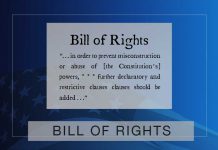Last Updated on October 3, 2021 by Constitutional Militia
The Internet is awash with articles in the patriotic ether that promote “secession” of one or more States from the United States as advisable, practical, and even necessary. Typically, the authors of these proposals define “secession” (at least implicitly) as the purported legal, political, and moral right of a State to leave the Union, unilaterally and at her own discretion, without the approval of or even any participation in the process by any other State or the General Government in Washington, D.C. Some of these authors contend that the Constitution itself allows for such “secession”. Others argue that, whatever the Constitution does or does not countenance in that regard, “secession” is now permissible, and even imperative, under the principles of the Declaration of Independence, because the General Government has, as a “Form of Government”, “become[ ] destructive of the[ ] ends” for which it was first instituted.
Inasmuch as the consequences of actions taken in reliance on such notions surely would be extremely serious, careful consideration of the merits of these recommendations is in order. And, hard as it may be for many people to accept, the conclusion must be that “secession” (as most of its advocates define it) is illegal, impractical, inopportune, and would be ineffective unless the “seceding” State successfully took prior actions that would make “secession” unnecessary in the first place.
A. Many advocates of “secession” assert that the Constitution is some form of “contract” among the States or between the States and the General Government. (Whether, having been “ordain[ed] and establish[ed]” as its Preamble attests by WE THE PEOPLE themselves, and not by “we the States” or “we the States and the General Government”, the Constitution is actually a political charter with different and more force than a typical “contract”, and pursuant to which neither the General Government nor any of the States enjoys any real “rights” as against THE PEOPLE, may be left to one side, so as to allow the greatest scope for the “secessionists’” arguments.) Now, the essence of any “contract”, whether economic or political in nature, is the existence of a binding, enforceable obligation to which every one of the parties must adhere, or suffer some penalty. The failure of any party to satisfy the terms and conditions of a true “contract” constitutes a “breach”, in response to which the other parties are entitled to seek some legal remedy, or in the absence of a legal remedy may themselves take some direct action. This is because each of the parties has what lawyers call “a reliance interest” with respect to every other party’s compliance with the agreement. In adhering to the “contract”, each party has “changed his position” in reliance upon the other parties’ compliance with the terms and conditions the agreement sets out, and will suffer some “damage” if any one of the other parties fails, neglects, or refuses to fulfill those obligations. If no binding, enforceable obligation exists—that is, if each of the parties may simply disregard the terms of the agreement at will, for any reason sufficient unto himself, and without significant cost—then the arrangement is no “contract” at all, but at most some kind of “gentlemen’s suggestion”.
Typically, to “secede” (that is, relieve himself) from the obligations of a true “contract”, a party must invoke some provision therein specifically allowing such action; or all of the parties must enter into a new “contract” rescinding their original agreement in favor of the party seeking to “secede”. And it may happen that, either in the provision of the original “contract” permitting “secession” or pursuant to the terms of the new “contract”, the “seceding” party will be required to pay some compensation, perform some other act, or agree to some future behavior as a condition precedent to “secession”. Sometimes, too, a party may be relieved of his obligations under a “contract” if another party materially breaches or refuses to perform his duties under the agreement. This, however, is not “secession” from the “contract”, strictly speaking. In any event, as will be discussed below, this apology for “secession” does not apply in America’s political circumstances.
1. The first inquiry must be: What obligations does the Constitution impose on the States; and what procedure, if any, does it provide by which the States may escape these obligations? (Of course, it is not necessarily true that, if the Constitution does impose obligations on the States, the Constitution is therefore necessarily a “contract” and the States parties to it. But examining the nature of any obligations the Constitution imposes on the States at least will illuminate what their degrees of freedom may be, whether or not the Constitution can properly be treated as a “contract”.)
In fact, the Constitution sets out some rather specific obligations directed towards officials of the several States: namely,
This Constitution, and the Laws of the United States which shall be made in Pursuance thereof; and all Treaties made, or which shall be made, under the Authority of the United States, shall be the supreme Law of the Land; and the Judges in every State shall be bound thereby, any Thing in the Constitution or Laws of any State to the Contrary notwithstanding.
The Senators and Representatives [in Congress] * * * , and the members of the several State Legislatures, and all executive and judicial officers, both of the United States and of the several States, shall be bound by Oath or Affirmation, to support this Constitution * * *
Article VI, Clauses 2 and 3 (emphasis supplied).
Plainly, if any State officials—whether of the legislative or executive branch—prepare, or participate in or counsel the preparation of, any purported “statute”, “ordinance”, “order”, or other alleged “law” of their State calling for “secession” in a manner inconsistent with “secession” as allowed under the Constitution, they thereby violate their “Oath[s] or Affirmation[s], to support th[e] Constitution”, and are guilty of false swearing or perjury. And “the Judges in every [such] State” would be required, at the peril of their own false swearing or perjury, to declare any such “statute” null and void ab initio. So, inasmuch as no State can take action except through her officials, no State may “secede” from the Union in a manner inconsistent with “secession” as allowed under the Constitution. So the question becomes, “Does the Constitution itself provide a means for ‘secession’ of any sort?”
Here, the Articles of Confederation offer some very useful preliminary instruction. Many proponents of “secession” look to the Articles as a general source of inspiration and example for interpretation of the Constitution. In the specific area of “secession”, however, this does them more harm than good. For Article XIII of the Articles explicitly provided that
[e]very state shall abide by the determination of the united states in congress assembled, on all questions which by this confederation are submitted to them. And the Articles of this confederation shall be inviolably observed by every state, and the union shall be perpetual; nor shall any alteration at any time hereafter be made in any of them; unless such alteration be agreed to in a congress of the united states, and be afterwards confirmed by the legislatures of every state.
Documents Illustrative of the Formation of the Union of the American States, House Document No. 398, 69th Congress, 1st Session (Washington, D.C.: Government Printing Office, 1927), at 35 (emphasis supplied).
Obviously, if “the union [was to] be perpetual” and no “alteration” in the Articles could be made “unless such alteration be agreed to in a congress of the united states, and be afterwards confirmed by the legislatures of every state”, “secession” from the Confederation was impossible without unanimous agreement among the States. Thus, the Articles did not assume that any State had an indubitable and unchallengeable inherent right to “secede” on her own recognizance from “the union”. Rather, the Articles set out a specific, very stringent, and exclusive procedure for “secession”—thereby precluding the invocation of any other means to that end. Inclusio unius exclusio alterius.
Perhaps to the consternation of cheerleaders for the Articles of Confederation, in its own Article V the Constitution establishes a procedure for “secession” less stringent than the Articles of Confederation required:
The Congress, whenever two-third of both Houses shall deem it necessary, shall propose Amendments to this Constitution, or, on the Application of the Legislatures of two thirds of the several States, shall call for a Convention for proposing Amendments, which, in either Case. shall be valid to all Intents and Purposes, as Part of this Constitution, when ratified by the Legislatures of three fourths of the several States, or by Conventions in three fourths thereof, as the one or the other Mode of Ratification may be proposed by the Congress * * * .
Obviously, ratification of an amendment by “Legislatures” or “Conventions” in “three fourths of the several States” (under the Constitution) is not as severe a requirement as “confirm[ation] by the legislatures of every state” (under the Articles of Confederation). Just as obviously, an “amendment” that allowed for some State to revoke her ratification of the Constitution, and thereby separate herself from the Union, would always be in order—because the only amendment that Article V disallows is that any “State, without its Consent, shall be deprived of its equal Suffrage in the Senate”, which limitation would not be transgressed if a State herself voluntarily sought to leave the Union and thereby willingly forfeited her entire “Suffrage in the Senate”. (So it is irrelevant that neither Article V nor any other provision of the Constitution actually uses the words “secede” or “secession”.) Obviously, too, if State officials put forward such an amendment providing for the “secession” of their State— whether in Congress, in the State’s own legislature, or in a constitutional “Convention”, they would not thereby violate their “Oath[s] or Affirmation[s], to support th[e] Constitution”, because they would be invoking the very procedure the Constitution itself establishes for that purpose. And, obviously, that the Constitution provides a perfectly adequate means for “secession” in Article V—consistent procedurally with the cognate provision of the Articles of Confederation—precludes any plausible argument that some other recondite means for “secession” lurks somewhere within (or less reasonably still, outside of) the Constitution. Inclusio unius exclusio alterius.
So, neither the Articles of Confederation nor the Constitution lends any support or even credence to the notion that a State enjoys an unilateral, totally discretionary “right to secede” from the Union without the agreement, to some degree, of the other States. This is because, as with any other “contract” (if, for purposes of argument, the Constitution can be assimilated to a “contract”), each State has a “reliance interest” in every other State’s adherence to the Constitution (except under the conditions and procedures that the Constitution itself recognizes for “secession”). And therefore each State has a claim to some say in, and probably compensation for, giving up her “reliance interest”.
So, as a condition of an amendment allowing (for example) South Carolina to “secede” from the Union, the States (including South Carolina) might agree that the newly independent mini-nation of South Carolina would not enter into any treaties with any country other than the United States for some term of years, or would always allow free trade between citizens of South Carolina and the United States, or would abide by some other mutually satisfactory requirements. For part two click below.




































